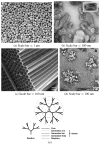Nanostructured materials for applications in drug delivery and tissue engineering
- PMID: 17471764
- PMCID: PMC3017754
- DOI: 10.1163/156856207779996931
Nanostructured materials for applications in drug delivery and tissue engineering
Abstract
Research in the areas of drug delivery and tissue engineering has witnessed tremendous progress in recent years due to their unlimited potential to improve human health. Meanwhile, the development of nanotechnology provides opportunities to characterize, manipulate and organize matter systematically at the nanometer scale. Biomaterials with nano-scale organizations have been used as controlled release reservoirs for drug delivery and artificial matrices for tissue engineering. Drug-delivery systems can be synthesized with controlled composition, shape, size and morphology. Their surface properties can be manipulated to increase solubility, immunocompatibility and cellular uptake. The limitations of current drug delivery systems include suboptimal bioavailability, limited effective targeting and potential cytotoxicity. Promising and versatile nano-scale drug-delivery systems include nanoparticles, nanocapsules, nanotubes, nanogels and dendrimers. They can be used to deliver both small-molecule drugs and various classes of biomacromolecules, such as peptides, proteins, plasmid DNA and synthetic oligodeoxynucleotides. Whereas traditional tissue-engineering scaffolds were based on hydrolytically degradable macroporous materials, current approaches emphasize the control over cell behaviors and tissue formation by nano-scale topography that closely mimics the natural extracellular matrix (ECM). The understanding that the natural ECM is a multifunctional nanocomposite motivated researchers to develop nanofibrous scaffolds through electrospinning or self-assembly. Nanocomposites containing nanocrystals have been shown to elicit active bone growth. Drug delivery and tissue engineering are closely related fields. In fact, tissue engineering can be viewed as a special case of drug delivery where the goal is to accomplish controlled delivery of mammalian cells. Controlled release of therapeutic factors in turn will enhance the efficacy of tissue engineering. From a materials point of view, both the drug-delivery vehicles and tissue-engineering scaffolds need to be biocompatible and biodegradable. The biological functions of encapsulated drugs and cells can be dramatically enhanced by designing biomaterials with controlled organizations at the nanometer scale. This review summarizes the most recent development in utilizing nanostructured materials for applications in drug delivery and tissue engineering.
Figures



References
-
- Kayser O, Lemke A, Hernandez-Trejo N. Curr Pharm Biotechnol. 2005;6:3. - PubMed
-
- Anderson DG, Burdick JA, Langer R. Science. 2004;305:1923. - PubMed
-
- LaVan DA, McGuire T, Langer R. Nature Biotechnol. 2003;21:1184. - PubMed
-
- Qiu LY, Bae YH. Pharm Res. 2006;23:1. - PubMed
-
- Svenson S, Tomalia DA. Adv Drug Deliv Rev. 2005;57:2106. - PubMed
Publication types
MeSH terms
Substances
Grants and funding
LinkOut - more resources
Full Text Sources
Other Literature Sources
Medical
